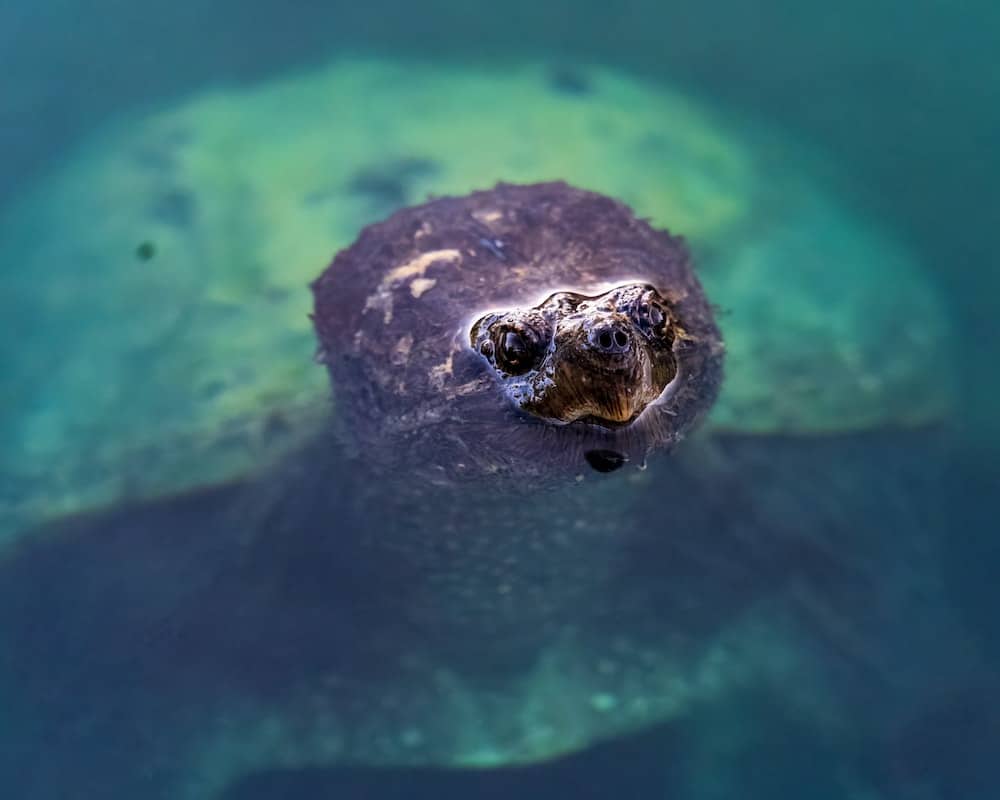There is indeed considerable confusion for many regarding the turtle’s vision. Some think these animals can see all colors like most humans, whereas some consider them colorblind. So what is the actual answer? Are they colorblind or not?
Well, the answer to this question, in short, is that they are not colorblind. They can see colors, but the difference is that they can see them vividly. Their color vision is not as brilliant and sharp as humans. A few scientists also believe that these reptiles similarly see colors to humans who are color blind. Additionally, these animals have CYP2J19, which is a gene-encoded enzyme. This gene helps these reptiles distinguish shades of red that tend to be invisible to the human eye.
It is also known that these reptiles don’t like the color black as it associates them with predators such as birds and snakes.
How Do Turtles See Color?
Similar to other animals, these reptiles have cones in their eyes that allow them to see various wavelengths of light.
Now, you must remember that there are different types of turtles, and not all have the same number of cones. The type and number of cones in the eyes of a turtle will differ.
Let us take an example of a box turtle. Box turtles are said to have fewer cones and are sensitive to specific wavelengths of light. Since there are fewer cones in their eyes, it can be hard for them to see and recognize particular colors.
What Colors Can These Reptiles See?
These animals have tetrachromatic color vision. This means that the cones in the eyes can recognize blue, green, orange, yellow, violet, red, and more.

Some turtles, such as the red-eared slider, have limited ability to recognize red wavelengths of light.
You must also know that they have the ability to see and recognize more shades of red than other mammals, including humans.
Now, let us dive a little deeper into the topic.
Sea Turtles
Let us talk about sea turtles to understand better how well they can see colors underwater.
Since the time of dinosaurs, turtle eyes have developed to see underwater and on land.
This means that they have advanced ultraviolet vision. This vision is more advanced than other fishes and helps them detect their prey underwater.
When we talk about advanced vision, it means that these reptiles can see UVB and UVA lights from a wavelength of 300 nm to 370 nm. UVB lights help them become superior underwater and catch their prey without fail. When we compare this to fishes, they have only UVA vision.
Comparing Them to Humans
When we compare these reptiles to humans, they can see colors from a wavelength of 300 nm to 370 nm, as mentioned before, and 400 nm to 740 nm. Humans can only perceive a visible spectrum from 400 to 720 nm approximately.
Additionally, these animals have a gene called CYP2J19. This is a red gene that helps them see and recognize different shades of red, which humans can not do.
This gene is believed to be inherited from a creature called archosaur, a 250 million-year-old species.
This gene also helps them see more yellow and orange hues along with red. This means that they can navigate very well on land and water easily.
What Colors Do They Like and Dislike?
We all have our favorite colors and a few ones we do not like. Just like us, even these reptiles have preferences. They like a few and dislike a few.
They Like
These reptiles are species of land and water. This can make you think that they are only attracted to blue and green, but that is partially true. They have a wide range they like depending on their species.
Let us take an example of a red-eared slider. This type of turtle is attracted to orange, red, and yellow. Now, on the other hand, painted turtles like subtle colors such as white and blue.
So, it is hard to specify specific colors for all species. It depends on each type.
They Dislike
Again, depending on the species, the colors will vary. That being said, one thing is common among all turtles.
These reptiles do not like extremely bright colors. Also, they do not like colors that are associated with their predators. For example, if their predator is in red or orange. They would move away from objects or places that are in those shades.
Additionally, many pet owners mentioned that their turtles hide or walk away from colors that are in neon shades (pink), dark red, and very dark ones.
If you are a turtle owner, you will be able to recognize the colors your turtle likes and dislikes based on its behavior.

Can They See in the Dark?
Let us begin with knowing that these animals can not see in complete darkness.
That said, when it is not pitch black, they can see but not very well. These reptiles do not have tapetum lucidum, a thin, light reflective membrane; they do not have too many rods in their eyes like night animals to help them navigate through the dark.
When it comes to vision at night, these reptiles are similar to humans. Just like humans, they can only recognize objects in shades of black in the dark. Turtle’s vision is similar to humans, but they have ultraviolet light and extra colors.
For example, if you place an object or scenery in the dark in front of a turtle and a human. Turtles and humans will see the same object and scenery in a similar manner, but these reptiles will see it with more red because of the CYP2J19 gene.
Overall, they are a little similar when we compare human’s and turtle’s night vision. Like us, even these reptiles take a few minutes to adjust their eyesight at night. Turtle’s eyes have been evolving and enhancing since the Permian period to find their way in the dark. They can see things to a certain extent in the dark and have the ability to sense ultraviolet glow.
How Do These Reptiles See Humans?
If you are wondering how they see us and what we look like to them, then you must know that these reptiles can adequately see and recognize humans based on our physical appearances. They try to remember your shape and size to identify you as their owner.
Additionally, with the help of the CYP2J19 gene, they can see humans in shades of yellow, red, and orange. Also, they can even notice humans underwater from a distance.
A healthy adult turtle can see the same vision as us and recognize humans with more shades of red.
Conclusion
Turtles are not colorblind. They can see color and shades of red due to the gene CYP2J19. If you have a turtle, you can experiment to see what your turtle likes and dislikes to understand your pet better.
Overall, these animals can see colors on land and water, making it easy to catch their prey. Also, they have advanced underwater vision, which makes them superior to other fishes.




